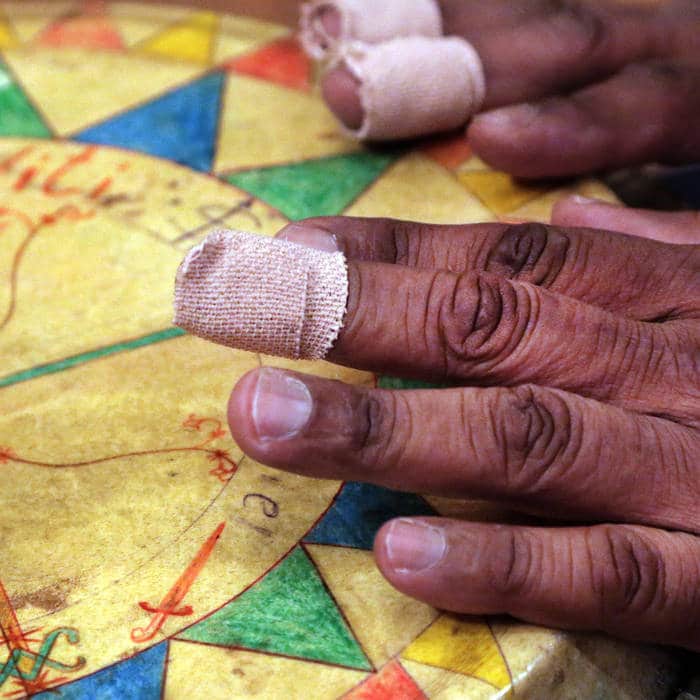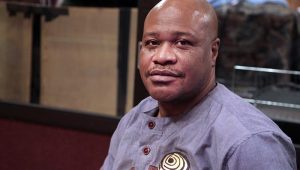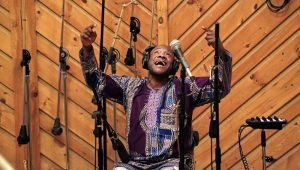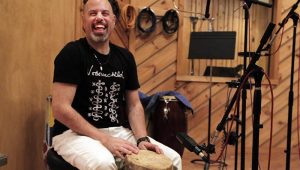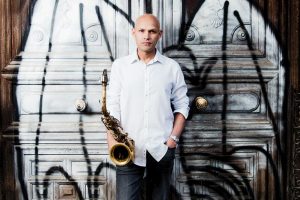Calling Down The Spirits
“In the tradition of Vodou, you call the spirit with the slow motion, a vibe, kase, for the spirit to enjoy the party. (This] is the rhythm that we call the yanvalou. After he’s enjoyed the party, you have to send the spirit away with a speed, because the time that the spirit takes to come, he doesn’t want to take the same time to go away. So you have to bring a fast rhythm, which is the mayi.”
Master drummer Daniel Brevil is describing ceremonies honouring Danbala, the lwa or spirit of creation in Haitian Vodou tradition. Commonly represented as a serpent, Danbala is a member of the Rada nanchon, a family of benevolent spirits. Brevil has felt a connection to Danbala since his childhood, when he found a two-headed snake under his bed. Writing music is his way of giving back to the spirits. Rada rhythms underpin two key tracks on Path Of Seven Colors, the second album from New York based composer and drummer Ches Smith’s collaborative project We All Break. The pieces combine contemporary improvised music with original and traditional songs brought to the group by Brevil. “Here’s The Light” is built around yanvalou, with a melodic/harmonic conception borrowed from Ornette Coleman. The title track is based on the mayi, with Brevil signalling changes through a series of kase, rhythmic breaks. The title alludes to a rainbow, associated with the Rada spirit Ayida but, as Brevil explains, it also reflects the nature of the music, which features many colours, sounds and rhythms: “That’s the rainbow in the recording.”
Listeners familiar with the angular, noisy character of Smith’s collaborations with Tim Berne, Mary Halvorson, John Zorn and Marc Ribot might be surprised by Path Of Seven Colors, but the drummer has been studying Haitian Vodou drumming and its traditions for over two decades. As he notes, many jazz qualities – polyrhythm, polytonality, improvisation, extended timbral awareness. tension and release – are present in Vodou drumming. Conscious of his outsider status and the “sketchy history” of appropriation, Smith kept his engagement with Vodou drumming “a bit of a secret” for several years. Yet he was keen to share the music and bring attention to its practitioners. He decided to start a project exploring the connections between Vodou music and his “own” music, recruiting avant garde pianist Matt Mitchell and his tanbou (drumming) mentors Brevil and Markus Schwartz for the first We All Break album in 2015.
“We had to figure out the form, I couldn’t really follow a model,” recalls Smith. “It’s definitely coming from the traditional drums. So I was basically writing around that, where Daniel as the lead drummer can just call in the drummers, which included Markus and myself. So that involves training Matt Mitchell to learn all those cues, so he can respond to the drums and not the other way around, you know? I’d say the majority of it still works that way.”
These traditional rhythms and songs are combined with a harmonic language familiar from Smith’s quintet These Arches, or The Bell, his 2016 album with Craig Taborn and Mat Maneri. “Part of this just comes down to my tendencies, I guess. There are certain tonalities I’m interested in, stacking triads, things like that. The first We All Break quartet record, I was consciously stacking, harmonising melodies in ways that I’ve heard in the Vodou tradition, where it’s very polytonal music. I was trying to get at some of that.”
For the new album, Smith has expanded We All Break to an octet including alto saxophonist Miguel Zenon and bassist Nick Dunston, plus master percussionist Fanfan Jean-Guy Rene and vocalist Sirene Dantor Rene from Vodou activism group Fan mi Asato. It was Brevil’s idea to bring in a female vocalist, and her presence elevates the whole sound, whether she’s part of the chorus or taking the lead. Zen6n’s clean, bright tone and nimble phrasing deftly bridge the soundworlds, while Dunston’s bass deepens the bottom end while embellishing the melodic aspects of Mitchell’s piano.
“I wanted it to be like in a ceremony,” says Smith. “It’s necessarily modular, like we’re on one thing, and then it just depends on what’s happening with the dance, or with the spirit, or even with the song, where a kase might come in. So it’s not set. I wanted anything to be able to happen at any time, like that kind of feeling, where we’re all listening and trying to stay in tune with whatever the vibe is that we need to be in tune with.”
“That’s exactly how the ceremony goes,” Brevil adds. “You don’t really think about what’s gonna happen. Sometimes the vibe just changes things instantly, for you to be in a different mood, and a different space.”
“And that is going back to the original idea of how the band might be able to work,” continues Smith. “That in the moment flexibility. And then when the group got expanded to eight people, there was a little bit more arranging. This is going to have this basic linear shape, but within that the kase can happen at any time. That’s why it was important for all the other musicians to know that sound and that feel for them to be able to incorporate it as part of their improvisation.”

